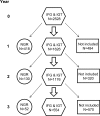Regression from pre-diabetes to normal glucose regulation in the diabetes prevention program
- PMID: 19587364
- PMCID: PMC2732165
- DOI: 10.2337/dc09-0523
Regression from pre-diabetes to normal glucose regulation in the diabetes prevention program
Abstract
Objective: Participants in the Diabetes Prevention Program (DPP) randomized to intensive lifestyle modification (ILS) or metformin had a significantly reduced incidence of diabetes compared with those randomized to placebo, yet most were still at risk because they had pre-diabetes. We explored the effect of baseline characteristics, weight change, ILS, and metformin on regression from pre-diabetes to the lowest-risk state of normal glucose regulation (NGR) defined by American Diabetes Association criteria.
Research design and methods: The DPP was a prospective randomized trial. Cox proportional hazards modeling was used to identify predictors of regression from pre-diabetes to NGR over 3 years of follow-up.
Results: Lower baseline fasting (hazard ratio 1.52, P < 0.01) and 2-h (1.24, P < 0.01) glucose predicted regression to NGR, as did younger age (1.07, P < 0.01) and greater insulin secretion (1.09, P = 0.04). ILS (2.05, P < 0.01) and weight loss (1.34, P < 0.01) had significant and independent effects on regression. A nonsignificant trend for regression was also observed for metformin (1.25, P = 0.06), male sex (1.17, P = 0.08), and insulin sensitivity (1.07, P = 0.09). In those entering the study with both impaired fasting glucose (IFG) and impaired glucose tolerance (IGT), male sex and insulin sensitivity predicted regression to isolated IFG, whereas ILS, metformin, female sex, and greater insulin secretion predicted regression to isolated IGT.
Conclusions: Insulin secretion, and other biologic processes retained with younger age, are key in restoring NGR in people with pre-diabetes. However, NGR may also be attained through weight loss and additional aspects of ILS.
Figures


References
-
- Mokdad AH, Ford ES, Bowman BA, Dietz WH, Vinicor F, Bales VS, Marks JS. Prevalence of obesity, diabetes, and obesity-related health risk factors, 2001. JAMA 2003; 289: 76– 79 - PubMed
-
- Meigs JB, Muller DC, Nathan DM, Blake DR, Andres R. The natural history of progression from normal glucose tolerance to type 2 diabetes in the Baltimore Longitudinal Study of Aging. Diabetes 2003; 52: 1475– 1484 - PubMed
-
- Tuomilehto J, Lindstrom J, Eriksson JG, Valle TT, Hamalainen H, Ilanne-Parikka P, Keinanen-Kiukaanniemi S, Laakso M, Louheranta A, Rastas M, Salminen V, Uusitupa M. Prevention of type 2 diabetes mellitus by changes in lifestyle among subjects with impaired glucose tolerance. N Engl J Med 2001; 344: 1343– 1350 - PubMed
-
- Buchanan TA, Xiang AH, Peters RK, Kjos SL, Marroquin A, Goico J, Ochoa C, Tan S, Berkowitz K, Hodis HN, Azen SP. Preservation of pancreatic β-cell function and prevention of type 2 diabetes by pharmacological treatment of insulin resistance in high-risk Hispanic women. Diabetes 2002; 51: 2796– 2803 - PubMed
Publication types
MeSH terms
Substances
LinkOut - more resources
Full Text Sources
Medical

